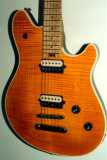Click on any image to see the full version. Over the past few years since I got out of school, I've managed to spend a good deal of my spare income on building a modest home studio. When I get the time (not very often these days), I enjoy using my toys to create music, some of which you can listen to here. The list of equipment includes:
The pictures below were taken in 1998 and are horribly outdated, as I've moved 4 times since then. But the basic idea remains the same.

Stepping into the room and looking to the left, you see the main console area of the studio. It includes the PC (not used for anything music related), the Mac (on the floor in the corner, obscured by the desk), the computer screen with Digital Performer running, below it the power conditioner to which everything is plugged in, the Roland tone module, and the Mackie 14-channel mixer to its right. The mixer now sits atop the DAT machine, which was acquired after this photo was taken. You'll also notice the "boombox" which, aside from headphones, is the only way I can listen to things. A decent set of monitors is pretty high on my wish list.
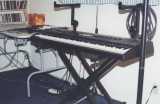
Turning to the right reveals the Alesis keyboard along the back wall of the room (for some perspective, notice some keys in the lower right corner of the "main console area" photo above). It's just a quick slide and turn of the chair away from the main work area.

Turning right again to face the wall opposite the console area, you'll see the land of the six strings (again for perspective, notice the very right end of the keyboard obscuring part of the acoustic guitar). The Johnson Millennium to the left is my main amplifier, with its two speakers both hooked up to its "left" outputs. The two speakers of the Peavey amp are hooked up directly to the Millennium's "right" outputs (the Peavey isn't even plugged in, its speakers are powered completely by the Millennium). This allows for a great stereo guitar sound.
I don't have a closeup of my Ernie Ball Music Man guitar because its purple finish looks very dark in most lighting conditions. I guess it's just camera shy or something. The above picture of all of the guitars is the only one I have where it doesn't look almost black (I've got several where it does).
The audio outputs of every piece of gear that makes noise are ultimately connected to the inputs of the mixer, which combines them according to how I have set the level sliders and EQ knobs for each channel. This output can then be monitored using my headphones or the boombox speakers, or any combination of channels may be alternately routed to the audio input on the Mac, where they will be digitally recorded using Digital Performer. The keyboard, tone module, and amplifier are also connected to the Mac via MIDI (yes, the amp also responds to MIDI control for program changes and effects parameter changes, a great feature). They can be controlled by the keyboard and/or the Digital Performer software on the Mac. The guitar amp can be recorded in two ways. The first is the traditional method for recording guitar amps, by placing a microphone (or two) in front of the speakers and recording what they pick up. This amp also has direct XLR outputs which can be hooked up directly to the mixer, bypassing the speakers and microphones. Since the speaker is a very important part of a guitar amp's tone, the amp's software provides speaker emulation for this method of recording. So you still get a nice tone instead of the typical very thin, buzzy sound you get from most amps when going direct without speakers. Everything is ultimately recorded by Digital Performer on the Mac, either in digital audio or MIDI form. Once a project is basically completed, I mix everything down to DAT. When I get a mix that I'm happy with, I then transfer it digitally from the DAT back to the Mac using a SP/DIF connection. Any final post production and edits are done on the Mac before the song is ready to be burned to CD. You can listen to some samples of my music.
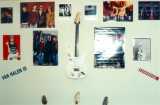 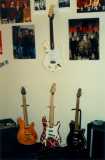  I recently attended the Van Halen Mailing List 1998 Convention in Las Vegas (and had a blast). Several prizes were given away in a drawing, including a Peavey bass autographed by Michael Anthony and a Fender guitar autographed by the whole band. I was very lucky that day and won the autographed bass. But the guy who won the autographed guitar is a bass player, so we ended up trading our prizes and now I have the guitar. It's a very low-end guitar, so I'm just keeping it as a piece of memorabilia to enjoy, not to play.
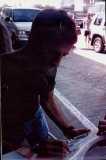 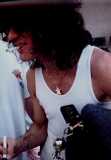 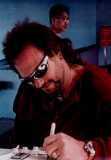 These are pictures of Gary Cherone, Edward Van Halen, and Michael Anthony signing the guitar. Unfortunately I got the guitar after it was signed, so I wasn't there to witness it. But these pictures prove its authenticity. Many thanks to Bill O'Neill who generously donated this guitar for the Convention giveaway!
|

